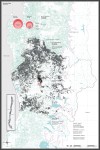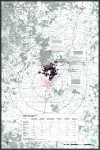The Plantation Games – Woodsheds and Sustainable Forestry
1 of 7
Forestry map illustrating total volume of wood in the Araucania region
When harvested responsibly, the use of wood as an alternative to steel and concrete in the building industry can be a major force in carbon sequestration and in the reduction of greenhouse gas emissions. Chile, as one of the leading wood producers in the world, recognizes this opportunity to use the production of wood to both bolster its economy and affect environmental change.
This project ties the ability to use wood as a building material to the process of metabolic urban growth. Using wood as a sustainable building resource at the scale of the city is dependent upon the amount of land available for planting, harvesting techniques, and the development of solid wood construction assemblies. This quantity of land is what we would call the city's 'woodshed' and is estimated by hectare based upon the quantity of wood needed to build different sized buildings. Just as the city is in a state of metabolic flux, so too is the woodshed as shifts in its size occur based on demand of wood products and different construction methodologies.
Material usage, in this case, is tied to thermodynamic performance. The development of hybrid CLT panels with choked cavities produce wall sections with significatly higher thermal resistances relative to their material usage.
Related Project: Multi-Family Housing






